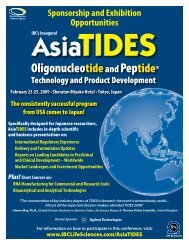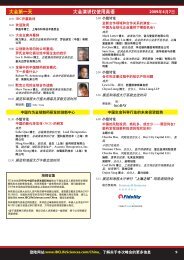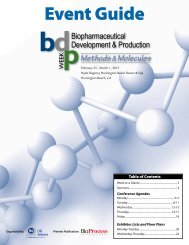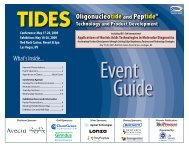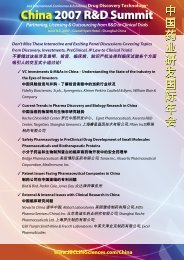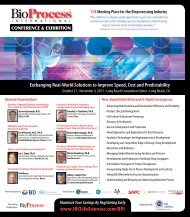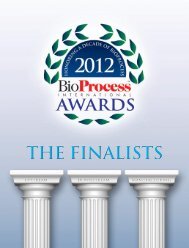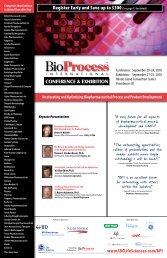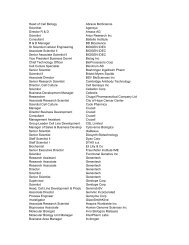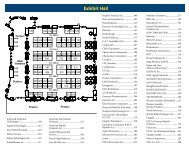Conference ⢠Tuesday, October 2, 2007 - IBC Life Sciences
Conference ⢠Tuesday, October 2, 2007 - IBC Life Sciences
Conference ⢠Tuesday, October 2, 2007 - IBC Life Sciences
Create successful ePaper yourself
Turn your PDF publications into a flip-book with our unique Google optimized e-Paper software.
Main <strong>Conference</strong> • <strong>Tuesday</strong>, <strong>October</strong> 2, <strong>2007</strong> (continued)12:00 Concurrent Technology WorkshopsDisposable BiopharmaceuticalProcesses – Advances and BenefitsBiopharmaceutical processes require a high investment in capital equipment, which start-upcompanies shy away from either due to financial restrictions and/or drug development risk offailure. However, the need for flexibility and lower investments costs are not only restricted tostart-up companies, but also research organizations with multiple product lines and processparameters or needs in fast track capacity increases. The highest potential to fulfill suchprocess role are disposable technologies, known as already implemented process steps andcompleted by new disposable equipment developments We will review existing disposableequipment and future disposable technologies to be introduced soon. Additionally cases willbe presented, which show the benefits of individual disposable equipment and processes.Maik W. Jornitz, Group Vice President – Product Management, Sartorius Biotech Inc.Multimodal Chromatography –For New and Old Separation ChallengesThe preparation of multi-modal chromatographic media, with thecombinatorial introduction of new interactions, allows an easiermodulation and enhancement of chromatographic performanceas compared to more traditional media. Such approach is particularly effective in thedesign of media with new selectivites and has led to the development of Capto MMCand Capto adhere. Design and application work will be presented.Henrik Ihre, Ph.D., Product Manager, GE HealthcareA Rational Approach to Culture Media Designand Basic Process IntegrationEffective and timely methods are required to successfullymeet product needs during development and ultimatelycommercial manufacture of recombinant therapeutics. Theability to both develop and manufacture high-quality optimized culture media is akey to success. Case studies will be presented to illustrate the use of Rational CultureMedia Design for rapid and effective media and process development.Scott D. Storms, Ph.D., Principal Scientist, Irvine ScientificAdvances in Clone Selection: CloningMedia and Selection Criteria are CriticalClone selection is a key step in cell line development. Recent advances have focused nearlyexclusively on high throughput instrumentation that allow more clones with the desiredphenotypic attributes to be screened, thereby enhancing the ability to find the best producersThis workshop will focus on our experience using the ClonePixFL instrument highlightingboth our development of better algorithms for clone selection, as well as the often overlooked,but critical need to develop appropriate cloning media.Peggy Lio, Process Science Fellow, Invitrogen2:00 Chairperson’s RemarksHoward L. Levine, Ph.D., President,BioProcess Technology Consultants, Inc.2:15 Future of Cell Line and Process DevelopmentMiniaturization and high throughput screening have provento be very powerful tools for the rapid improvement of celllines for antibody production. Productivities in the range of1 g/l to 5 g/l have become achievable for CHO basedproduction. Examples will be given of how these same toolscan be used to improve the speed of process development.The focus on cellline development will increasingly switch to timelines and for this the Pichiabased platform for making antibodies with human glycosylation offers somevery interesting possibilities. Pichia offer two main attractions; the biology isknown in much better detail and the doubling time is several fold shorter.Barry C. Buckland, Ph.D., Research Vice President BioProcess R&D,Merck Research Laboratories3:00 Interactive Panel Discussion on the Future ofDownstream Processing: How Best to Handle HigherBioreactor Outputs and Greater Product DemandsFive experts will present their views on the evolving nature of downstream processing.Each speaker will give his views on how best to make downstream processing robustenough to handle the larger quantities of product produced with increased bioreactortiters, discuss ways to how to make chromatography sufficiently robust and productiveto meet these higher product demands, and also present alternative technologies thatmay replace or supplement chromatography for very large scale recovery. Followingthe brief speaker presentations, audience participation will be encouraged to join thediscussion and share their views on the topic.Moderator:Howard L. Levine, Ph.D., President, BioProcess Technology Consultants, Inc.Panelists:John Curling, Chief Executive Officer, John Curling Consulting AB, SwedenMichael R. Ladisch, Ph.D., Distinguished Professor and Director, Laboratoryof Renewable Resources Engineering, Weldon School of Biomedical Engineering,Purdue UniversityAlan Klotz, Ph.D., Research Advisor, Bioprocess Development,Eli Lilly and CompanyFred Larimore, Ph.D., Director of Scientific Affairs, Cook PharmicaAbhinav Shukla, Ph.D., Associate Director, Manufacturing <strong>Sciences</strong>,Bristol-Myers Squibb12:30 Networking Luncheon in Exhibit and Poster HallPlenary Session • <strong>Tuesday</strong>, <strong>October</strong> 2, <strong>2007</strong>Keynote Presentations and Featured Discussion3:45 Networking Refreshment Break in Exhibit and Poster Hall4:15 Regulatory ModernizationThe Center for Drug Evaluation and Research is focusing onachieving the desired state for pharmaceutical productmanufacturing: “A maximally efficient, agile, flexiblepharmaceutical manufacturing sector that reliably produceshigh quality drug products without extensive regulatoryoversight.” Factors include international harmonization, pharmaceuticaldevelopment information, risk management, quality systems, and newtechnologies. This presentation will focus on implementation of the desired stateincluding quality by design with special attention given to biotech products.Helen N. Winkle, Director, Office of Pharmaceutical <strong>Sciences</strong>, CDER, FDA5:00 Industry Expectations of the NewPharmaceutical Quality Assessment SystemFor industry, utilization of science and risk-basedapproaches to product development should lead to a moreflexible regulatory environment with the establishment of “DesignSpace” and articulating the life-cycle commitments through theRegulatory Agreement. This should in turn lead to a regulatory environmentthat is more amenable to technical innovation. For the regulators, gettingknowledge-rich submissions will help reviewers and investigators gain a thoroughunderstanding of the product and any critical elements and risks associated withthe manufacturing processes and controls. Most importantly, patients will beassured of a continuous supply of high quality medicines.Tobias Massa, Ph.D., Vice President, Global Regulatory <strong>Sciences</strong> – CMC,Bristol-Myers Squibb5:45 Networking Reception in Exhibit and Poster HallSponsored by5:45-7:00 Dedicated Poster ViewingPoster presenters are asked to be at their posters.10 Visit www.<strong>IBC</strong><strong>Life</strong><strong>Sciences</strong>.com/BPI/US for up-to-date information on this event





